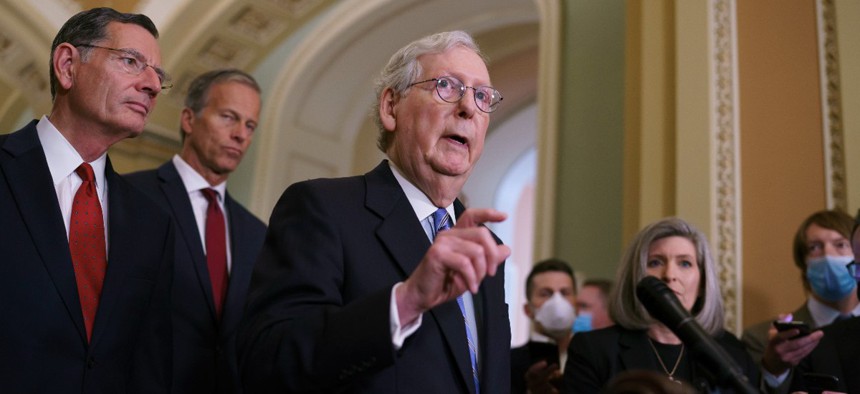Senate Votes to Punt Debt Crisis to December After Lawmakers Strike Deal

Senate Minority Leader Mitch McConnell, R-Ky., joined from left by Sen. John Barrasso, R-Wyo., and Senate Minority Whip John Thune, R-S.D., speaks to reporters after a Republican policy meeting at the Capitol in Washington, Tuesday, Oct. 5, 2021. J. Scott Applewhite / AP
Congressional leaders have yet to spell out how they will avoid potential delayed paychecks for feds in the long term.
Lawmakers have reached a bipartisan agreement that will raise the debt ceiling, with the Senate on Thursday passing a bill to temporarily avoid an unprecedented default on U.S. debt that would have caused significant disruption for federal agencies and the economy.
Congress is poised to raise the nation’s borrowing limit by $480 billion, enough to pay the government’s bills through Dec. 3. That would align the new debt deadline with the expiration of a stopgap spending bill that is currently funding agencies, though the Treasury Department would likely be able to create additional flexibility by taking what it calls “extraordinary measures” to limit its daily expenditures.
Senate Republicans and Democrats struck the deal after Minority Leader Mitch McConnell, R-Ky., offered for his party to cease its actions that have so far prevented Congress from addressing the debt limit. Republicans have insisted Democrats pass a long-term debt measure on their own through a process called reconciliation, which would allow the majority party to approve the bill on its own with only 51 votes. While Democrats accepted McConnell’s offer and approved the two-month debt limit extension Thursday, they have maintained they will not use reconciliation to address the next deadline.
Lawmakers have expressed optimism they can agree to full-year appropriations bills when the current continuing resolution expires, but no such confidence exists for the next debt deadline. Both parties have said they will stick to the same demands that caused a standoff in recent weeks, paving the way for the same contours to shape the debate in December.
“We have reached agreement to extend the debt ceiling through early December,” Schumer said on the Senate floor Thursday, without addressing how he plans to address the situation in the long term.
McConnell said the agreement would avoid the “manufactured crisis” that would result from default. He added it would give Democrats more time to raise or suspend the debt ceiling through his preferred method of reconciliation. A sufficient number of Republicans joined Democrats in a procedural vote Thursday to overcome a filibuster, but were united in voting for its final passage.
Karine Jean-Pierre, a White House spokeswoman, on Thursday called the deal a “positive step forward,” but called on Republicans to stop playing “political games.”
“It gives us some breathing room from the catastrophic default we were approaching because of Sen. McConnell’s decision to play politics with our economy,” Jean-Pierre said.
The House will have to vote on the debt ceiling measure before it heads to President Biden’s desk. The lower chamber previously approved a standalone bill to suspend the borrowing limit into December 2022, but the Senate scrapped its likely doomed vote on that measure in favor of the short-term compromise. Treasury has warned the government is likely to default on Oct. 18, absent congressional action.
There is no blueprint for how the government would operate if it breaches its debt ceiling, though it is clear agencies would not be able to carry out their normal operations. Because typical spending outpaces the revenue the Treasury Department brings in on a given day, the federal government would only be able to pay 60% of its bills in a given month of a default scenario, according to a Bipartisan Policy Center estimate.
Analysts and Treasury officials have sketched out two possible outcomes during a default: the government would either delay payments until it collected enough revenue to cover them, or prioritize some payments while allowing others to go unpaid. In either scenario, agency payments to beneficiaries, states, grantees, contractors and, potentially, their own employees, could be disrupted. Some federal workers could be furloughed or tasked with working on the promise of back pay in the future.






